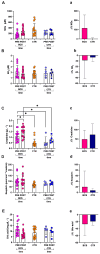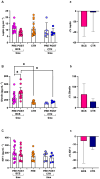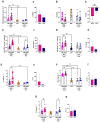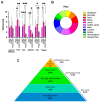Systemic Responses Towards Oxy-Inflammation, Hormones, and Mood in Breast Cancer Survivors: Preliminary Evidences from Dragon Boat Endurance Race
- PMID: 40217981
- PMCID: PMC11989338
- DOI: 10.3390/jcm14072532
Systemic Responses Towards Oxy-Inflammation, Hormones, and Mood in Breast Cancer Survivors: Preliminary Evidences from Dragon Boat Endurance Race
Abstract
Background/Objectives: Endurance exercise increases oxygen demand and, when not balanced by antioxidant defenses, consequently, oxidative stress and inflammatory cytokines increase too. In breast cancer survivors (BCS), post-treatment, physical capacity decreases, lowering life quality. Dragon boat (DB) paddling has shown benefits in reducing lymphedema and improving psychological well-being. This study aimed at non-invasively investigating in BCS, by means of saliva and urine samples, the systemic responses to oxy-inflammation, and appetite hormones after a DB endurance race. Methods: 15 BCS and 15 healthy women (5 (CTR) who performed the DB race too) were studied. BCS and CTR were monitored pre- and post-race. Reactive oxygen species (ROS) production, total antioxidant capacity (TAC), lipid peroxidation (8-iso), DNA oxidation (8-OH-dG), nitric oxide metabolites (NOx), inflammation markers (IL-6-10 and TNFα), appetite hormones, electrolytes concentration, psychometric, and physical scales were assessed. Results: At rest, compared to healthy women, BCS showed a significant increase in oxy-inflammation biomarkers. BCS showed a general increase in oxy-inflammation parameters compared to CTR after the DB race. In BCS, there were the following results: ROS: +80%; lipid peroxidation: +103%; DNA oxidation: +44%; interleukins-6: +179%; IL-10: +55%; TNFα: +9%, NOx: +60% increases and unbalanced appetite hormones: leptin (-32%); and ghrelin (+53%). Moreover, the dragon boat offered a holistic approach to recovery, addressing emotional and social needs supporting belonging, love, and esteem needs, reported to be about 56% of the motivations in this activity, while post-race the following increased: a sense of fatigue (+55%); tiredness (48%); a cold sensation (+15%); and +32% pain. Conclusions: This study provided evidence that, in BCS, a DB endurance race produces an important imbalance in the oxy-inflammation state, at the same time being accompanied by a positive impact on subjective mood and general wellness. Future studies should focus on long-term effects.
Keywords: breast cancer; dragon boat; endurance; exercise; hormones; inflammation; mood; oxidative stress; quality of life; women.
Conflict of interest statement
The authors declare no conflicts of interest.
Figures






Similar articles
-
Keep calm and keep rowing: the psychophysical effects of dragon boat program in breast cancer survivors.Support Care Cancer. 2024 Mar 8;32(4):218. doi: 10.1007/s00520-024-08420-7. Support Care Cancer. 2024. PMID: 38456933 Free PMC article.
-
Dragon boat racing and health-related quality of life of breast cancer survivors: a mixed methods evaluation.BMC Complement Altern Med. 2013 Aug 5;13:205. doi: 10.1186/1472-6882-13-205. BMC Complement Altern Med. 2013. PMID: 23915045 Free PMC article.
-
Team triathlon effects on physiological, psychological, and immunological measures in women breast cancer survivors.Support Care Cancer. 2020 Dec;28(12):6095-6104. doi: 10.1007/s00520-020-05457-2. Epub 2020 Apr 20. Support Care Cancer. 2020. PMID: 32314053 Clinical Trial.
-
The Effect of Dragon Boating on the Quality of Life for Breast Cancer Survivors: A Systematic Review.Healthcare (Basel). 2024 Jun 27;12(13):1290. doi: 10.3390/healthcare12131290. Healthcare (Basel). 2024. PMID: 38998825 Free PMC article. Review.
-
Prevalence and risk factors of sleep disturbances in breast cancersurvivors: systematic review and meta-analyses.Support Care Cancer. 2019 Dec;27(12):4401-4433. doi: 10.1007/s00520-019-04936-5. Epub 2019 Jul 25. Support Care Cancer. 2019. PMID: 31346744
Cited by
-
The Adjuvant Effect of Hyperbaric Oxygenation for Loxosceles rufescens Bite: A Case Series.Metabolites. 2025 Jul 10;15(7):470. doi: 10.3390/metabo15070470. Metabolites. 2025. PMID: 40710570 Free PMC article.
References
-
- Guerrerom C., Collado-Boiram E., Martinez-Navarrom I., Hernandom B., Hernandom C., Balinom P., Muriachm M. Impact of Plasma Oxidative Stress Markers on Post-race Recovery in Ultramarathon Runners: A Sex and Age Perspective Overview. Antioxidants. 2021;10:355. doi: 10.3390/antiox10030355. - DOI - PMC - PubMed
LinkOut - more resources
Full Text Sources
Miscellaneous
